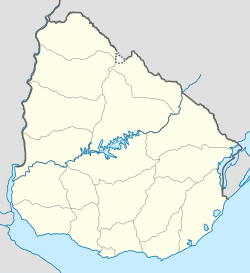Río Branco, Uruguay
Rio Branco | |
|---|---|
City | |
 Baron of Mauá International Bridge over Yaguarón River | |
 Rio Branco Location in Uruguay | |
| Coordinates: 32°35′50″S 53°23′0″W / 32.59722°S 53.38333°WCoordinates: 32°35′50″S 53°23′0″W / 32.59722°S 53.38333°W | |
| Country | |
| Department | |
| Population (2011 Census) | |
| • Total | 14,604 |
| Time zone | UTC -3 |
| Postal code | 37100 |
| Dial plan | +598 4675 (+4 digits) |
Río Branco is a city in the Cerro Largo department of northeastern Uruguay, on the Brazilian border.
Name[]
The words Rio Branco mean "white river" in Portuguese. However, the name does not refer to any local river; it is a tribute to Brazilian diplomat José Paranhos, Baron of Rio Branco, who negotiated the definitive borders of Brazil and Uruguay. Hence the Portuguese name, instead of Spanish Río Blanco (although the city's name has an acute accent on the first word that is required in Spanish, but absent from the Portuguese spelling).
Location[]
It is located at the east end of Route 26, about 86 kilometres (53 mi) east-southeast of the department capital city of Melo.
Geography[]
The Yaguarón River (Portuguese: Rio Jaguarão), which forms the natural border with Brazil, flows along the city's northern limits. Right across the river lies the Brazilian town of Jaguarão, with the Baron of Mauá International Bridge joining the two cities.
History[]
On 31 August 1915, the villa (town) previously known as Artigas was given its present name by Act of Law 5330.[1] On 1 July 1953, its status was elevated to a ciudad (city) by Act of Law 11,963.[2]
Population[]
In 2011, Río Branco had a population of 14,604.[3]
| Year | Population |
|---|---|
| 1908 | 4,106 |
| 1963 | 4,023 |
| 1975 | 5,685 |
| 1985 | 9,072 |
| 1996 | 12,215 |
| 2004 | 13,456 |
| 2011 | 14,604 |
Source: Instituto Nacional de Estadística de Uruguay[1]
Places of worship[]
- (Roman Catholic)
References[]
- ^ Jump up to: a b "Statistics of urban localities (1908–2004)" (PDF). INE. 2012. Retrieved 3 September 2012.
- ^ "LEY N° 11.963". República Oriental del Uruguay, Poder Legislativo. 1953. Retrieved 9 September 2012.
- ^ "Censos 2011 Cuadros Cerro Largo". INE. 2012. Archived from the original on 10 October 2012. Retrieved 25 August 2012.
External links[]
| Wikivoyage has a travel guide for Río Branco. |
- Uruguay geography stubs
- Populated places in the Cerro Largo Department
- Cities in Uruguay
- Uruguay (geography) articles


